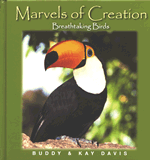
God Created Cohorts
Bird and Mammal Plant Pollinators
The great variety in color, shape, pattern, and scent we observe in flowers is a direct result of the intimate association of the flowers with their animal partner pollinators or cohorts. With a symbiotic (dependent) mutualistic relationship (mutually beneficial), the plant expends less energy in pollen production and more energy in producing showy flowers, nectar, and/or odors. By attracting a specific pollinator on a regular basis, this specialized flower has an advantage of wasting less pollen versus flowers that attract indiscriminate pollinators. The pollinator gains an advantage of having its own private food source, thereby exerting less energy in food competitions between other pollinating species. The plant must supply a reward (nectar and pollen), an attractant (brightly colored flowers or odor), and a mechanism for pollen transfer (flower tubes, strong landing pads, etc.). Animal-pollinated plants have large, irregular shaped pollen grains covered with hooks, spines, or craters. A rough texture and sticky surface ensure that the pollen grains will stick to the visiting animal’s hair, feathers, or appendages. The pollen stays on the animal until it visits another flower where the pollen is rubbed off onto the other flower’s stigma, resulting in fertilization. Fertilization and continued production of new plants is the flower’s reward.
The plant and pollinator have adapted together under God’s original design.
The plant and pollinator have adapted together under God’s original design. Some species have unique and harmonious relationships, which could not have arisen randomly. Insect and plant symbiotic relationships were discussed in a previous article (God Created Cohorts: Insect Plant Pollinators1). This article will discuss unique pollinating relationships between plants birds and mammals.
Excluding insects, bats, and birds are the main animal pollinators. There are a few plants that have entered into pollination partnerships with such diverse creatures as mice, possums, some primates, and even snails or earthworms. Animals use flowers as sources of food for themselves and their offspring. Animal-pollinated flowers produce nectar, a sugar-based substance containing vitamins, amino acids, and other nutrients. The amount of nectar a flower typically produces relates to the physical needs of its pollinators.
Mammal Pollinators: Bats
The diets of bats vary from species to species, but you can group bats by three main types of feeding preference. Many species are generalists and display opportunistic feeding behavior, feeding on whatever is available. Insectivorous bats feed primarily on night-flying insects. Frugivorous bats eat fruit and nectivorous bats feed on nectar from plants. Bats rely on sight and smell (perfumed flowers & nectar) to locate their food sources, and since they feed in the evening hours, night blooming flowers are a main nectar source. Many of the nectar-eating bats have long thin tongues like hummingbirds that can reach deep into the flower for the nectar. Nectar feeding bats also have short ears and long slender noses for reaching into flowers and big eyes for excellent vision. In contrast to the fluttering zig-zagging flight of insect-catching bats, the flight of the nectar bats is strong and direct. Being strong fliers they can hover while they drink the nectar and not disturb the flower too much. Pollen grains cling to the bat’s fur and are carried to the next plant ensuring fertilization of their food source. Bananas, mangoes, dates, figs, peaches, cashews, guava, avocados, and agaves rely on bats for pollination.2
Nectar-drinking bats in the tropics play indispensable roles in maintaining forest diversity and in assisting forest regeneration through seed dispersal and pollination. There are a large number of plant species which grow in tropical forests, however most individual species are low in number and scattered throughout the forest. This scenario represents a dilemma for pollination. How do you transfer pollen effectively from the flowers of one tree to another when the distance between these individuals may be over 300 feet. The answer to this pollination problem is solved by flying insects, birds, and bats.3 Experiments concluded that bats can transfer nearly four times as much pollen as hummingbirds. Below are a few examples of interesting bat pollinators.
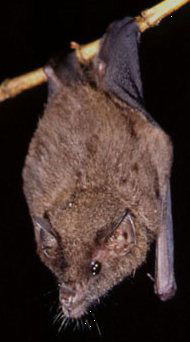
Figure 1. Geoffroy’s Tailless Bat4
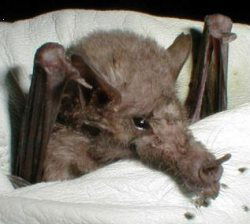
Figure 2. Mexican Long-tongued bat5
The Tube-Lipped Nectar Bat (Anoura fistulata) was discovered in the forests of the Andes of Ecuador in 2005. Researchers report that this nectar bat can launch its tongue one and a half times its body length, longer than any other mammal and second only to chameleons among vertebrates. Also, this bat extends its tongue twice as far as its other scientific family members. The bat adapted6 a longer tongue to feed on a tubular flower (Centropogon nigricans) where the nectar is located at the end of an equally long funnel. Just like humans, the bats tongue begins at the base of the mouth, so the only way to stretch tongue length would be to grow an equally long snout. But that’s not what happened with this bat. The base of the long tongue is pushed back into the rib cage, and is stored between the heart and sternum. That gives the Tube-lipped nectar bat sole pollinating rights to the flower.7
To ensure a bat’s head will be dusted with pollen, a flower must be wide enough to fully accommodate its snout. Geoffroy’s tailless bats (Anoura geoffroy, Figure 1) have a long tongue and elongated muzzle which allows them to visit wide tube flowers. Tropical Burmeistera flowers are intensely dependent on bats for survival. Flowers of Burmeistera have a tubular base that expands into a bell shape. Researchers studied flowers of nine species of Latin American Bell flowers (Burmeistera species) that were dull green in color, with varying amounts of purple, and emitted odors ranging from faint (B. succulenta) to very strong (B. borjensis and B. multiflora). All nine study species had flowers that opened in the early evening, and they are primarily bat-pollinated (Anoura geoffroyi and A. caudifera). The bat-pollinated flower species were duller in color, had a wider opening, shorter flower tube and more rigid flower stems than other flower species (B. rubrosepala) that are hummingbird pollinated.8 Since the bats are sometimes found in areas without Burmeistera plants and forage on nectar from other flowers, the bat is not dependent on the Burmeistera for survival.
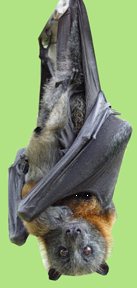
Figure 3. Grey-headed Flying Fox with baby9
In the United States, only three species of nectivorous Long-tongued bats (Leptonycteris nivalis, L. curasoae, and Choeronycteris Mexicana, Figure 2) are found in the northern limit of their range. Arizona is host to two nectivorous bats (L. curasoae and C. mexicana) which are critical to the pollination of columnar cacti (saguaro and organ pipe) and agave desert plants. Pollination of agave and various cacti would drop approximately 97% without nectivorous bats. Lesser long-nosed bats Leptonycteris curasoae) are food specialists, feeding on cactus (Organ pipe, Cardon and saguaro) and Agave flowers (Agave palmeri). Lesser long-nosed bats ensure that the desert ecosystem remains healthy and cactus populations continue to survive, by pollinating their flowers and dispersing their seeds.10 Greater long-nosed bats (Leptonycteris nivalis) synchronize their migration from Mexico and arrival in Texas to coincide with the summer blooming cycle of agave plants upon which they rely for pollen and nectar. Is it not clear how important partnerships are for the survival of plants and animals?
Another fascinating relationship involves flying foxes. Flying foxes are large bats weighing up to 2 pounds, with a wing span that may exceed three feet. They consume fruit and nectar and are important pollinators and seed dispersers of native trees. The Grey-headed Flying-fox (Pteropus poliocephalus, Figure 3) is a native species that is endemic to Australia. It flies up to 25 miles to forage in flowering gum trees such as the spotted gum (Corymbia maculate), eucalyptus, paperbarks, and banksias. It is estimated that a single flying fox can dispense up to 60,000 seeds in one night. This is a very important mechanism for rainforest re-vegetation.11 Not all bats are “scary and blood-thirsty,” as some believe. They serve interesting and important roles in God’s natural world.
Hummingbirds
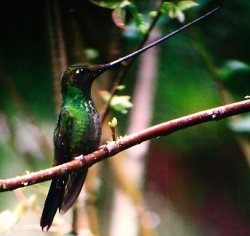
Figure 4. Sword-billed Hummingbird12
Hummingbirds play an important role in the pollination of numerous species of shrubs and vines, some of which are specifically adapted to hummingbird pollination. Throughout the Americas it is estimated that 8,000 plant species have flowers whose principal pollinator is a hummingbird. Generally, the plant and hummingbird relationships are facultative and not fully dependent on each other for survival. The plant has a beneficial relationship with its pollinator, but because there are many species of hummingbirds and many varieties of flowers to pollinate, a unique and dependent partnership is absent. Of course there are always exceptions to the rule. In Peru there is one rare species of bird, the Sword-billed hummingbird (Enisfera ensifera, Figure 4), which has a beak long enough (4 inches) to pollinate the Long-tubed tasconia (Passiflora mixta).13
As we discussed earlier, flower structure design may facilitate pollination by a primary pollinator and restrict other ineffective pollinators. After hummingbirds are acquired as reliable partner pollinators, continuing selection may favor other traits that make the flowers even more specialized for hummingbird pollination. Flowers manifest variation in corolla length, corolla width, and flower color. An example of this is red coloration in hummingbird-pollinated flowers. The red coloration may develop primarily to discourage visitation by bees and therefore preserve pollen for hummingbird visits.14 Scientists have learned that bees require more time to find red flowers than blue ones.15 Therefore, the bees will stay at a blue patch of flowers rather than exerting time and energy searching for red flowers.
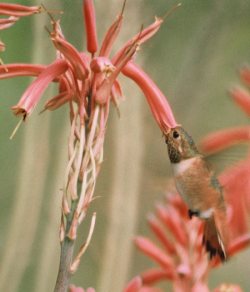
Figure 5. Allen’s Hummingbird’s forehead being dusted with pollen16
Bees use scent to locate flowers, can carry more pollen than hummingbirds, and tend to deposit most grains in the first few flowers visited. Hummingbirds use sight to locate flowers, deposit pollen grains more evenly across a group of flowers and, because of their higher metabolic rates, ingest more nectar than bees. Consequently, hummingbird-pollinated plants usually have little or no fragrance and produce greater amounts of nectar than bee-pollinated plants. Consider, if you were a flower designer, how would you design flowers to attract pollinators?
The majority of hummingbird flowers grow horizontally, permitting the hummingbird to enter from the side, but with some, like fuchsia, its flowers hang down and must be approached from below. In some hummingbird pollinated flowers (Aphelandra species, Penstemon barbatus)17 the size of the opening of the flower is just a fraction wider than the hummingbird’s head. The flower anthers and stigmas are positioned at the right length so that pollen is deposited on the hummingbird’s forehead (Figure 5). Usually hummingbirds can insert their bills and access nectar without even moving the flower. Just like the bat, the hummingbird picks up the pollen then transfers it to the next flower. Hummingbirds are physically designed to drink nectar from tubular-shaped blossoms. Bill designs influence the types of flowers that are utilized by each species of hummingbird. Long bills fit into long floral tubes. Short-billed hummingbirds visit short-tubed flowers. These different partnerships allow long-billed and short-billed pollinators to coexist with minimal competition. Bill shape can also be categorized as straight or curved downward (decurved, Figure 6). Bill curvature generally corresponds to straight or strongly curved floral tubes. Another unique design is the hummingbird tongue. The tongue has grooves on the sides that collect nectar.

Figure 6. Baron’s Hermit Ecuador (Phaethornis longirostris)18
In order to consume enough nectar to survive, hummingbirds must visit hundreds of flowers daily. They are excellent fliers in terms of maneuverability and can fly up to 60 miles per hour, with their long, blade-like wings. Unlike other birds, this bird’s wing connects to the body at the shoulder joint. This adaptation allows the wing to rotate almost 180°, enabling the bird to fly forward, vertically, laterally, backward (the only bird able to do so), and upside down. The backward flight is possible because the muscles that lift the wing are as well-developed as the down-stroke muscle. Only hummingbirds have wing muscle strength on the up-stroke. This bird can also hover. Hummingbird wings are larger in proportion to their body weight than that of non-hovering birds of similar size. Hovering permits a hummingbird to spend a minimal quantity of time at each flower, moving on without having to land and take off. Some hummingbird species are capable of visiting and sampling 20 flowers per minute. However, hovering is the most energetically expensive form of flight. What unique features God has designed in this tiniest of birds.19
Throughout the world, very few flowers are pollinated exclusively by one animal species. Hummingbird-adapted flowers can be visited by insects, and insect-pollinated flowers are visited by hummingbirds. For instance, long-tongued bees and butterflies often share flowers with hummingbirds. One-to-one partnerships are rare but there are some interesting relationships.
In Western North America, hummingbird-pollinated flowering time comes in seasonal waves from Mexico to Alaska. These plants provide nutrition for hummingbirds migrating north to breed. Within a mountain range, hummingbird plant flowering often progresses as a wave from low elevation to high, creating a vertical food resource up the mountain. Hummingbird plants are concentrated along the north-south mountain ranges on the western side of the American continent, and these are the same corridors used by hummingbirds as they migrate north and south each year. At the end of the Northern migratory route, few hummingbird-pollinated plant species occur (five in southern Alaska), but in the mountain region, at the end of the southern migration route (Sierra Madres in Mexico, Central America; Andes in Peru), the number of hummingbird-pollinated species increases dramatically. It is no coincidence that Central America and the Andes Mountain region have the highest hummingbird diversity on the planet, for here is where most of the important nectar plants thrive.20 Table 1 lists the Western breeding hummingbirds of the United States and their nectar plant partners.
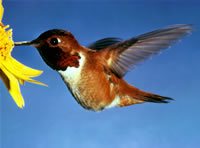
Figure 7. Rufous Hummingbird21
Of special note: Rufous hummingbirds (Figure 7) have been called the most important hummingbird pollinator in Western North America. This is because they migrate from Alaska to Mexico, pollinating plants their entire journey.
The Ruby-throated Hummingbird (Archilochus colubris) is eastern North America’s only breeding hummingbird. Most of these hummingbirds winter in Mexico & Central America, but a few overwinter in Florida. The Ruby-throated hummingbird’s long, thin bill is perfectly adapted to the deep tubular flower of plants like the trumpet creeper. Table 2 contains a general, but not exhaustive, list of Eastern North American plant species used for nectar by this bird.
Table 1. Western hummingbirds that breed in the U.S. and their nectar plant partners.
| Hummingbird (Scientific name) | Western Location22 | Nectar Flowers23 |
|---|---|---|
| White-eared (Hylocharis lucotis) | Arizona; Mexico; Central America | Beardlip penstemon (Penstemon barbatus) Blue beardtongue (Penstemon virgatus) Cardinal beardtongue (Penstemon cardinalis) Desert Tobacco (Nicotiana obtusifolia) Desert willow (Chilopsis linearis) Indian paintbrush (Castilleja integra) Mescal bean (Sophoa secundiflora) Mountain giant hyssop (Agastache pallidiflora) Octillo (Fouquieria splendens) Pale desert thorn (Lycium pallidum) Parry’s agave (Agave parryi) Red sage (Salvia penstemonoides) Scarlet gilia (Ipomopsis aggregata) |
| Berylline (Amazilia beryllina) | Arizona; Mexico; Central America | |
| Violet-crowned (Amazilia violiceps) | Arizona, New Mexico, Mexico | |
| Blue-throated (Lampornis clemenciae) | Arizona, New Mexico, Texas; Mexico | |
| Magnificent (Rivoli’s) (Eugenes fulgens) | Arizona, New Mexico; Mexico | |
| Broad-billed (Cynanthus latirostris) | Arizona, New Mexico, Texas; Mexico | |
| Lucifer (Calothorax lucifer) | Arizona, New Mexico, west Texas; Mexico | |
| Buff-bellied (Amazilia yucatanensis) | Texas; Mexico; Belize | |
| Anna’s (Calypte anna) | Western coastal U.S.; Mexico | Black Sage (Salvia mellifera) Bladderpod (Isomeris arborea) Box thorn (Lycium andersonii) California figwort (Scrophularia californica) California honeysuckle (Lonicera hispidula) Cardinal Catchfly (Silene laciniata) Coast hedge nettle (Stachys chamissonis) Coastal monkeyflower (Mimulus dentatus) Snowberry (Symphoricarpos albus fasicuculatus) Canyon Gooseberry (Ribes menziesii) Fringe cup (Tellima grandiflora) Indian warrior (Pedicularis densiflora) Oak gooseberry (Ribes quercetorum) Orange Monkey Flower (Diplacus aurantiacus) Toyon (Heteromeles arbutifolia) Mendocino Bushmallow (Malacothamnus) Pacific madrone (Arbutus menziesii) Purple owl’s clover (Castilleja exserta) Red elderberry (Sambucus racemosa) Red Larkspur (Delphinium nudicaule) Red Monardella (Monardella macrantha) Salmonberry (Rubus spectabilis) San Luis Purple Sage (Salvia leucophylla) Scarlet Bugler (Penstemon centranthifolius) Scarlet Larkspur (Delphinium cardinale) Scarlet Monkeyflower (Mimulus cardinalis) Thistle sage (Salvia carduacea) Western columbine (Aquilegia formosa) |
| Costa’s (Calypte costae) | Western coastal U.S.; Mexico | |
| Allen’s (Selasphorus sasin) | Western coastal U.S.; Mexico | |
| Calliope (Stellula calliope) | Western Canada; Washington, Oregon, Idaho, Montana, California, Nevada; Mexico | Western coastal species listed above plus: Hairy honeysuckle (Lonicera hispidula) Kinnikinnick (Arctostaphylos species) Native Lilies (Lilium species) Nuttall’s larkspur (Delphinium nuttallianum) Orange honeysuckle (Lonicera ciliosa) Payette beardtongue (Penstemon payettensis) Scarlet paintbrush (Castilleja miniata) Showy penstemon (Penstemon payettensis) Small-flowered penstemon (Penstemon procerus) Western snowberry (Symphoricarpos occidentalis) |
| Rufous (Selasphorus rufus) | Western Canada; Washington, Oregon, Idaho, Montana, N. California, Mexico | |
| Black-chinned (Archilochus alexandri) | Washington, Idaho, Wyoming, Colorado, Utah, California, Nevada, Arizona, New Mexico; Mexico | Arizona and Coastal species listed plus: Colorado columbine (Aquilegia caerulea) Firecracker penstemon (Penstemon eatonii) Golden currant (Ribes aureum) Hairy honeysuckle (Lonicera hispidula) Honeysuckle (Lonicera involucrata) Kinnikinnick (Arctostaphylos species) Native Lilies (Lilium species) Rydberg’s penstemon (Penstemon rydbergii) Showy penstemon (Penstemon speciosus) Snowberry (Symphoricarpos alba) Sticky geranium (Geranium viscosissimum) Wavy leaf paintbrush (Castilleja applegatei) Whipple’s penstemon (Penstemon whippleanus) |
| Broad-tailed (Selasphorus platycercus) | Idaho, Wyoming, Colorado, Utah, Nevada, Arizona, New Mexico, Mexico, Central America |
Table 2. Eastern U.S. plants pollinated by Ruby-throated hummingbirds
| Common Name (Scientific name) | Common Name, (Scientific name) |
|---|---|
| Bee-balm (Monarda spp.) | Obedient plant (Physostegia virginiana) |
| Blazing star (Liatris spp.) | Red buckeye (Aesculus pavia) |
| Cardinal flower (Lobelia spp.) | Sage (Salvia spp.) |
| Buttonbush (Cephalanthus occidentalis) | Swamp milkweed (Asclepias incarnata) |
| Crossvine (Bignonia capreolata) | Trumpet honeysuckle (Lonicera sempervirens) |
| Limber honeysuckle (Lonicera dioica) | Trumpet vine or creeper (Campsis radicans) |
| Milkweed, butterfly weed (Asclepias tuberosa) | Wild columbine (Aquilegia canadensis) |
| Native lilies (Lilium spp.) | Woodland pinkroot (Spigelia marilandica) |
Other Bird Flower Pollinators
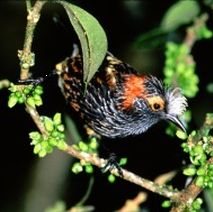
Figure 8. Crested Honeycreeper24
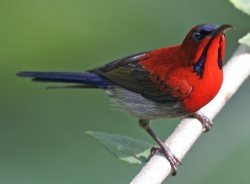
Figure 9. Crimson Sunbird25
Hawaiian honey creepers obtain nectar from and pollinate flowers which are usually large, colorful, and red. These flowers have a characteristically twisted corolla which fits the curved beak of the bird. Plants pollinated by crested honeycreepers (Palmeria dolei) (Figure 8) are the Ohi’a lehua (Metrosideros polymorpha), many native hibiscus, and native Lobelia flowers (such as Trematolobelia macrostachys).26
Sunbirds are small, largely nectarivorous perching birds with long, slender, sharply pointed, decurved bills. The sunbirds are thought to pollinate several tree species of the Nigerian forest. The importance of sunbirds as pollinators is largely unknown and is being studied. Sunbirds do hover, although for shorter time spans than hummingbirds. Usually these birds will perch to obtain nectar.
The Crimson Sunbird (Aethopyga siparaja, Figure 9), has been known to stab the bottom of the flower base and steal nectar without pollinating the plant. Not a very desirable behavior for a pollinator to undertake. The Malachite sunbird (Nectarinia famosa) is the largest of the group and naturally visits large red flowers of aloes, proteas, Candelabra Flower (Brunsvigia orientalis), and Wilde Dagga (Leonotis species).27
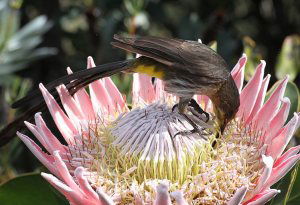
Figure 10. Cape Sugarbird on Protea cynaroides28
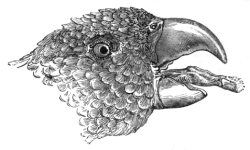
Figure 11. Lorikeet drawing depicting “brush tongue.”29
Sugarbirds are a small group of perching birds that reside exclusively in Africa. They are specialist nectar feeders with a long down-curved bill and long tail feathers. They primarily feed on Protea plants. The Cape sugarbird (Promerops cafer, Figure 10) also pollinates the black protea (Protea lepidocarpodendron) shrub. The black protea flowers stigma stays closed until the flowers’ pollen is removed by the sugarbird.30
The brush-tongued parrot (Trichoglossus haematodus) of Australia and New Guinea has a specialized and unique tongue for feeding on nectar. Tiny hair-like structures line the end of the tongue in the shape of a U. When one of these parrots extends its tongue during feeding the hairs stand on end, like bristles on a brush, and allow nectar and pollen to be easily soaked up.31
Terrestrial and Arboreal Mammal Pollinators
It is estimated that over 50 species of land mammals actively visit and pollinate native flowers. These include several species of possums, arboreal mammals such as marsupials, small primates, and some rodents.32 Flowers pollinated by primates tend to be unscented and very large in order to accommodate their heavier body weight. Flowers pollinated by marsupials usually grow higher in the tree canopy while flowers pollinated by rodents tend to be located at ground level.33 Below are some examples of fascinating relationships from various regions.
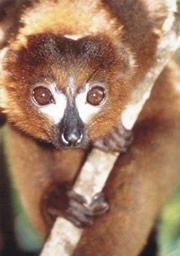
Figure 12. Red-Bellied Lemur34
The Red-Bellied Lemur (Eulemur rubriventer, Figure 12) is an endemic primate of Madagascar. The red-bellied lemur is mainly a fruit eater, but also feeds on leaves, nectar, and flowers. This animal will lick the nectar out of flowers leaving them unharmed. Red-bellied lemurs visit and presumably pollinate the flowers of the traveler’s palm (Ravenala madagascariensis) and possibly Brexia and Parkia plants.

Figure 13. Sugar glider35
The Sugar glider (Petaurus breviceps, Figure 13) is a small gliding marsupial from Australia. These mammals leap from tree branches and glide much like the North American flying squirrels. There are seven species of sugar gliders that live in trees and eat insects small vertebrates and eucalyptus sap. The yellow-bellied glider, Petaurus australis, feeds on the nectar of Banksia and Eucalyptus.
The honey possum (Tarsipes rostratus), in the same order as the sugar glider (Diprotodontia), is a tiny mammal with a body length of 3 to 4 inches. It is not, however, a close relative of the sugar glider and is one of the few truly nectarivorous mammals. The animal’s long, pointed snout and long, extensible, and brush-tipped tongue allow it to gather pollen and nectar of native Australian Banksia and Adenanthos plants.

Figure 14. Monito del monte36
In the temperate forest of South America, the seeds of the mistletoe (Tristerix corymbosus) are dispersed solely by another marsupial known as Monito del monte (Dromiciops gliroides, Figure 14). The current scientific order (Microbiotheria) of this mouse-like marsupial contains one family and one species. However, some scientists are working on the theory that Monito is more closely related to the Australian marsupials.37 The important point is that this created “kind” of animal has a unique role in its environment. In the temperate forests of Patagonia, Monito, is the sole seed dispersal agent of the parasitic mistletoe which grows on the bark of tall trees. Nearly 100 families of birds and mammals rely on mistletoe for fruit, nectar, and nesting material. The seeds of mistletoe do not survive intact when other animal species eat them. Only the Monito passes the seeds undamaged through its digestive tract and deposits them directly onto the bark of host trees.38 This mutual partnership is key to the biodiversity of the whole forest.
In South Africa, flowers of Massonia lilies (Massonia depressa) are visited at night by at least four rodent species: two gerbils, the hairy-footed gerbil (Gerbillurus paeba) and Cape Short-eared Gerbil (Desmodillus auricularis); plus 2 muridae species, the Namaqua Rock Rat (Aethomys namaquensis) and Cape Spiny Mouse (Acomys subspinosus). The flowers of this lily are situated at ground level and are not brightly colored. The nectar is gathered from a well-structured bowl-shaped open chamber. Large volumes of nectar were found in individual Massonia flowers during the night.39
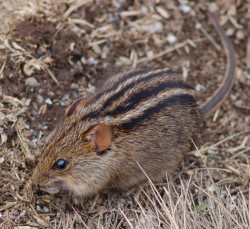
Figure 15. Striped mouse40
Several species of gerbils, mice, rats, and shrews also visit flower heads of some South African sugarbush (Protea amplexicaulis, Protea humiflora, Protea nana). Flower heads are usually hidden inside the sugarbush at ground level where they are accessible to rodents. Rodents are attracted by a strong musty odor and are rewarded with copious amounts of a thick sugar nectar. In order to prevent birds and insects from stealing this nectar, rodent-pollinated Proteas have inconspicuous brown or black bracts (modified leaves). The insides of the bracts may be pale white and the tips of the flowers may be shiny red. These features guide the rodent to the nectar in the dark. The nectar is contained within a tube, and the distance to the nectar equals the length of the rodents snout, about 0.5 inches. Pollen is deposited on the head of the rodent.41 The nectar of rodent-pollinated Protea species has a higher sugar concentration than that of bird-pollinated species.42 Rodent pollinators of Protea nana include; Namaqua Rock Mouse (Aethomys namaquensis), Striped mouse (Rhabdomys pumilio, Figure 15), and Verreaux’s White-footed Rat (Myomyscus verreauxi).
From all of the examples discussed we have learned how different flowering plant species possess or developed a variety of strategies to achieve the pollination of their flowers to ensure a new generation of plants. Some plants rely on the wind to move pollen, but most depend on the contact of an insect, bird, or animal. Flower structure, scent, and growth form vary between plant species. This allows different plants to attract different pollinators. The pollinators in turn have various features, or mechanisms, by which they obtain and carry the pollen to the next plant (Figure 16). In some cases, the link between the plant species and its pollinator has become so close that each is dependent on the other for its continued existence. This is a clear reminder of another relationship: the one between man and God the Creator.
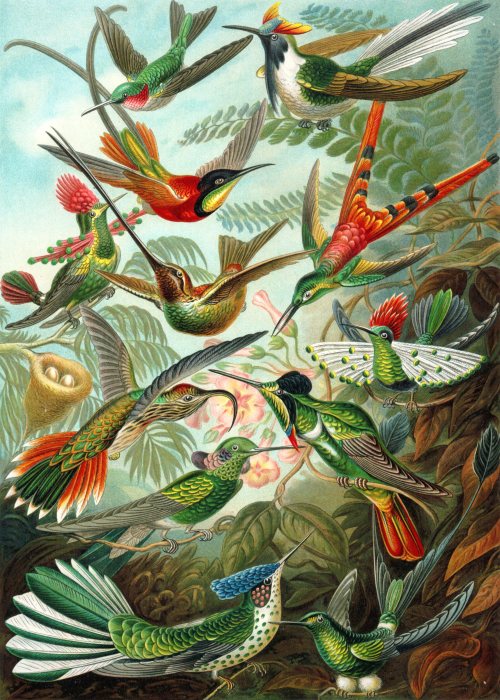
Figure 16. Twelve members of the Hummingbird family43
Footnotes
- God Created Plant Pollinator Partners
- USDA. 2005. Native Pollinators. Fish and Wildlife Habitat Management Leaflet 34.
- Peters, Charles M. 1994. Sustainable Harvest of Non-timber Plant Resources in Tropical Moist Forest: An Ecological Primer. Biodiversity Support Program, World Wildlife Fund, www.worldwildlife.org.
- Photo Credit: NBII.gov
- Photo Credit: National Park Service, www.NPS.gov
- Physical adaptations allow plants and animals to better adapt and survive in their new environment (post-Flood). Adaptation implies changes in the genetic makeup which allow an organism to survive better in a given environment. The changes do not add information: they alter genetic information. God designed the created kinds with genetic information that could be utilized when required to adapt to new environments. In other words, the Creator continues to accomplish His purpose for organisms after creation, not by creating new kinds, but by working through existing components that were designed during Creation Week. See also Hennigan, Tom, Georgia Purdom, and Todd Charles Wood, 2009. Creation’s Hidden Potential. Answers 4 no. 1:70–75.
- Bryner, Jeanna. 2006. Batty Discovery: The Longest Tongue. LiveScience.
- Muchhala, Nathan. 2006. The pollination biology of Burmeistera (Campanulaceae): specialization and syndromes. American Journal of Botany 93:1081–1089.
- Photo Credit: Wikimedia Commons
- Fleming, Theodore H. 1991. Following the Nectar Trail, Bats Magazine, 9, no. 4: 4–7.
- Department of Environment, Climate Change and Water, NSW Government of Australia. The Royal Botanic Gardens Wildlife Notes. Online at: http://www.rbgsyd.nsw.gov.au.
- Photo Credit: Wikimedia Commons
- Ulmer, Torsten, and John M. MacDougal. 2004. Passiflora: passionflowers of the world, Portland, Oregon: Timber Press.
- Raven P. H. 1972. Why are bird-visited plants predominantly red? Evolution 26: 674.
- Spaethe, J., J. Tautz, and L. Chittka. 2001. Visual constraints in foraging bumblebees: flower size and color affect search time and flight behavior. Proc Natl Acad Sci USA 98 no. 7:3898–903. Online at: www.ncbi.nlm.nih.gov.
- Photo Credit: U.S. Fish & Wildlife Service, http://www.fws.gov/digitalmedia
- Castellanos, M.C., P. Wilson, and J.D. Thomson. 2003. Divergence of Pollination Modes in Penstemon. Evolution 57 no. 12:2742–2752.
- Photo Credit: http://life.nbii.gov/dml/mediadetail.do?id=6716&pt=l2&l2PageId=50013&sDir=ta José Loiza, Aves y Conservación.
- Dreves, Denis. 1992. The Hummingbird—God’s Tiny Miracle. Creation 14, no. 1:10–12. Online at: https://answersingenesis.org/birds/the-hummingbird-gods-tiny-miracle/.
- Gibson, Arthur C. 2000. Why Do Our Hummingbirds Hum, Member newsletter 3 no. 3. Mildred E. Mathias Botanical Garden. Online at: http://www.botgard.ucla.edu/html/membgnewsletter/Volume3number3/Hummingbirds.html.
- Photo Credit: Dean E. Biggins/U.S. Fish and Wildlife Service, www.fws.gov
- Species (main) geographical ranges were taken from: Gough, G.A., J.R. Sauer, M. Iliff. 1998. Patuxent Bird Identification Infocenter. Version 97.1. Patuxent Wildlife Research Center, Laurel, MD. www.mbr-pwrc.usgs.gov/id/framlst/infocenter.html.
- The pollinator plant lists were adapted from North American Pollinator Protection Campaign and Pollinator Partnership, Selecting Plants for Pollinators online guides available at: pollinator.org. This list is of commonly known nectar plants and is not exhaustive of all plant species a hummingbird may utilize.
- Photo Credit: USGS
- Photo Credit: Wikimedia Commons
- Crested Honeycreeper. Available online at: www.fws.gov/pollinators/Features/FeaturedPollinator.html
- How Sunbirds harvest nectar from flowers. Available online at: besgroup.talfrynature.com/2006/03/12/how-sunbirds-harvest-nectar-from-flowers/
- Photo Credit: Wikimedia Commons
- Photo Credit: Wikimedia Commons
- Sunbirds and Sugarbirds: Important Pollinators in the Old World Tropics. Available online at: www.nbii.gov/portal/server.pt/community/international_birds/1314/sunbirds_and_sugarbirds/4218
- Parrots: Psittaciformes - Rainbow Lorikeet (trichoglossus Haematodus): Species Account animals.jrank.org/pages/773/Parrots-Psittaciformes-RAINBOW-LORIKEET-Trichoglossus-haematodus-SPECIES-ACCOUNTS.html.
- 2007 Coevolution Institute and North American Pollinator Protection Campaign Report to the Natural Resources Subcommittee on Fisheries, Wildlife and Oceans, U.S. House of Representatives. Available online at: www.pollinator.org
- Johnson, Steven D., Anton Pauw, and Jeremy Midgley. 2001. Rodent pollination in the African lily Massonia depressa (Hyacinthaceae). American Journal of Botany, 88:1768–1773. Botanical Society of America, Inc. Online at: www.amjbot.org.
- Photo Credit: Wikimedia Commons
- Photo Credit: Wikimedia Commons
- Photo Credit: Wikimedia Commons
- Aplin, K. P., and M. Archer. 1987. Recent advances in marsupial systematics with a new syncretic classification. Pp. xv-lxxii in Archer, M. (ed.), Possums and Opossums: Studies in Evolution, Vol. I. Sydney: Surrey Beatty and Sons PTY Limited.
- Amico, G., M. Rodriguez-Cabal, M. Aizen. 2009. The potential key seed-dispersing role of the arboreal marsupial Dromiciops gliroides. Acta Oecologica. 35:8–13.
- Parrots: Psittaciformes - Rainbow Lorikeet (trichoglossus Haematodus): Species Account animals.jrank.org/pages/773/Parrots-Psittaciformes-RAINBOW-LORIKEET-Trichoglossus-haematodus-SPECIES-ACCOUNTS.html
- Photo Credit: Wikimedia Commons
- Protea Atlas Project, South African National Biodiversity Institute, online at: protea.worldonline.co.za.
- vanTêts, lan G., S.W. Nicolson. The nutritional ecology of rodent pollinators of Protea in South Africa, online at http://horizon.documentation.ird.fr/exl-doc/pleins_textes/divers09-03/010028466.pdf
- Photo Credit: Wikimedia Commons Author Ernst Haeckel Kunstformen der Natur (1904), http://commons.wikimedia.org/wiki/File:Haeckel_Trochilidae_labels.jpg
Recommended Resources

Answers in Genesis is an apologetics ministry, dedicated to helping Christians defend their faith and proclaim the good news of Jesus Christ.
- Customer Service 800.778.3390
- Available Monday–Friday | 9 AM–5 PM ET
- © 2025 Answers in Genesis


